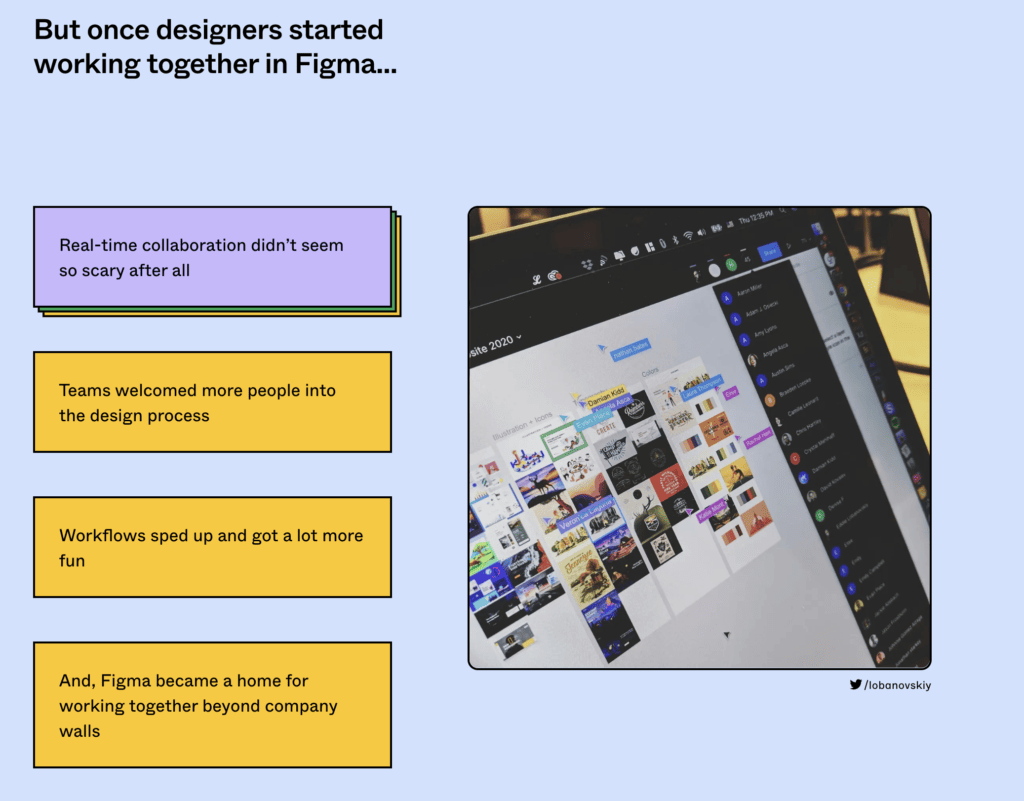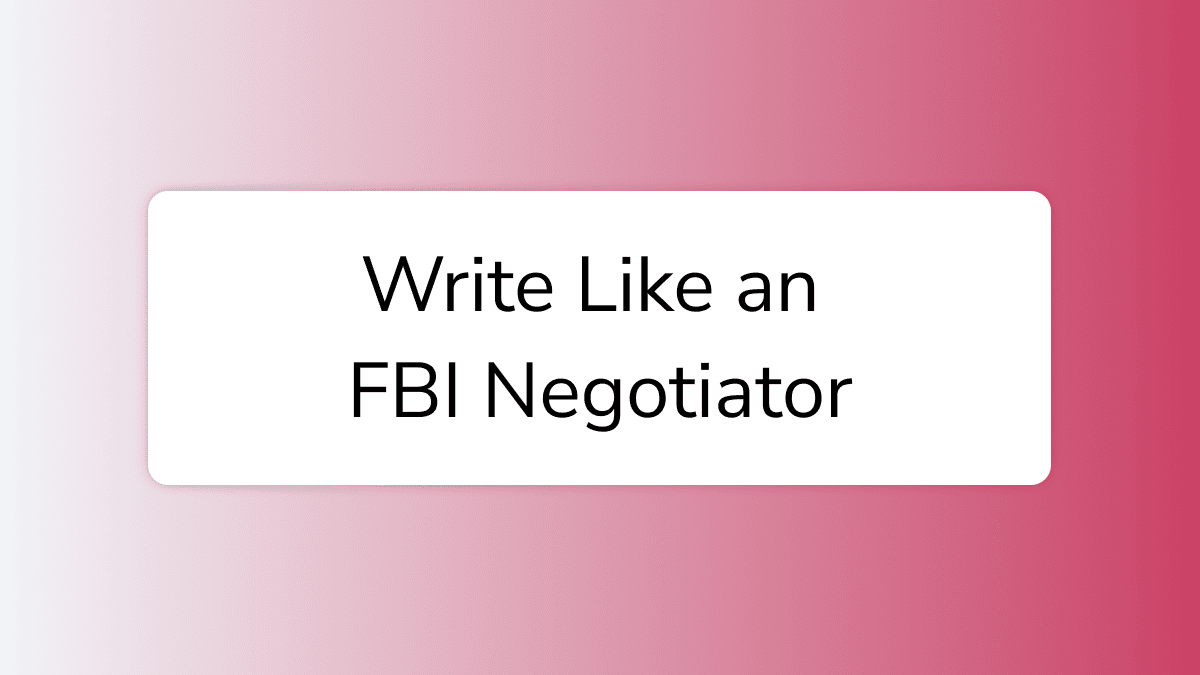Marketing copy is a negotiation on steroids.
When it comes to copywriting, the goal isn’t just to inform or entertain. It’s to persuade. To convince. To negotiate.
And who better to learn negotiation tactics from than the FBI?
In this article, we’ll explore how you can apply FBI-inspired negotiation strategies to your marketing copy to craft a narrative that negotiates with your reader toward the desired action – with listening and connecting, not sleazy sales tactics.
Applying Negotiation Strategies to Copywriting
Any good businessperson enters a negotiation armed with as much information about the other side as possible. And your marketing and sales copy is no different.
In the start-up world, your first iteration of everything from your website to email marketing and sales scripts often comes directly from the founders. So how can negotiating techniques help?
Overcoming Objections Through Preparation
Objections are the roadblocks that prevent your audience from taking the desired action. And the key to overcoming them?
Preparation.
As Christopher Voss and Tahl Raz point out in their book, Never Split the Difference, that’s all about applying FBI negotiating tactics to your business:
“A good negotiator prepares, going in, to be ready for possible surprises”
This is the same approach you should take when writing your copy. Anticipate potential objections and address them directly in your marketing copy. Whether that’s on your website, in an email, or in a 30-second TikTok – the purpose is the same.
Make your audience feel seen and heard, increasing trust, and increasing the likelihood of them choosing your solution.
So, how do you prepare for these objections?
It’s all about customer listening. Understand the common objections your customers have to choosing you and overcome these objections through your copy – before your team even gets on a sales call or an email pops into your customer service inbox.
Emotions as a Copywriting Tool
Even the most rational decision-makers are subconsciously driven by emotion.
In fact, 95% of purchase decisions take place subconsciously, influenced by intuitive, emotional decisions.
Even when we think we’re being rational, we’re highly influenced by intuition and emotions.
Therefore, managing emotions and digging under the surface to find the true root of your customer’s pain are essential parts of your marketing.
You’re not just selling a product or service, you’re selling the outcome and the emotions tied to it.
Yes, even in B2B marketing. Every business purchasing decision has key stakeholders behind it who are driving the decision, so identifying those stakeholders and the emotions that are driving them are your key to heightening the emotion that drives more conversions.
The key is to identify and influence the right emotions through your copy. Understand the emotions your audience is feeling right now and how they want to feel in the short and long term.
The only way to do this? Research, research, research. Use methods like customer interviews and review mining to dig deep and listen to the emotional drivers of your ideal customers. (More on how we use those later)
Demonstrate Your USP – Emphasis on the SP
Not every unique point is a unique selling point.
To convince your audience that your solution is the best, you need to understand their emotional drivers and frame the key benefits of your solution in a way that resonates with them.
Emphasise what makes you different from your competitors or the way your customer is solving the problem right now – but only if that differentiator is something your audience cares about.
“If you can get the other party to reveal their problems, pain, and unmet objectives—if you can get at what people are really buying—then you can sell them a vision of their problem that leaves your proposal as the perfect solution.”
Chris Voss, Never Split the Difference
A good negotiator – and therefore a good marketer – doesn’t just sell a service, they sell a vision, a story, and an emotion.
To do this, you need to understand what your audience truly wants and needs. This involves finding the root of their pain and flipping it to uncover their end goal or dream state.
Thinking point: what does your ideal customer want their life to look like after choosing to buy from you?
From Understanding to Action: The Switching Perspective
Convincing your audience to switch from their current solution to yours can be challenging.
The psychology behind switching brands or products is complex. Your audience needs to feel that the benefits of switching outweigh the pains of staying.
Essentially, your copy needs to plead the case that switching is worth it.
To achieve this, you need to understand what they’re switching from and the perceived pains of switching. No matter whether they’re using a competitor, are DIY-ing it, or don’t have the right processes in place at all – whatever the case, your audience is always switching from something to choose your solution.
Thinking point: What have they already invested? What are the perceived pains of switching? How can we reduce them?
Then, you can craft copy that makes the case for change – by emphasising the pains of staying versus the benefits of switching.
Take this example from Crunch, who offers online accounting services and software for business customers. Their homepage headline speaks directly to why the switch will be worth it by painting a picture of what life will be like for the customer in just seven words.
The psychology of moving your audience from feeling their pain to pleading the case for ‘The Switch’ has an interesting effect:
It allows your audience to feel like they’re equally as responsible, or solely responsible, for the “Aha Moment” they feel during that switch that drives them to say yes to your offer.
So how do you do this? Talk to your customers, listen, and spot patterns.
Empathy: The Heart of Effective Copy
Empathy is what it all comes down to.
Understanding and addressing the perspective of your ideal customers is crucial for writing impactful copy that actually converts (and for ensuring your solution is what they signed up for – but that’s a whole other blog post).
Empathy in copywriting is about putting your audience at the centre of every message you put out.
“Empathy is paying attention to another human being, asking what they are feeling, and making a commitment to understanding their world.”
Chris Voss, Never Split the Difference
Your prospects have 1,000’s of marketing messages thrown at them every single day. Brands that ‘get them’ and empathise with their problems are the brands that hook attention.
This section of Figma’s About Us page, exemplifies what true empathy looks like. They call out the emotions that design teams were feeling, show the reader what life could be like and heighten the emotions they’re invoking in every sentence.

In the next section, we’ll delve into the practical methods you can use to gather the necessary information to apply these negotiation tactics to your marketing copy.
Gathering the Right Information: Our Approach
When it comes to crafting compelling copy that resonates with your audience, understanding their needs, pains, and desires is crucial.
Here’s a breakdown of our favourite research methods to gather the right information about your ideal customers that can change the narrative of your marketing copy:
Feedback Analysis
We start by analysing direct feedback and customer communications from various sources:
- Sales call recordings
- Onboarding communications and thank-you page surveys
- Churn or exit surveys
- Customer testimonials
We even send out surveys or conduct interviews with customers ourselves to get a more in-depth understanding of their needs and experiences with our client’s brands.
What are we looking for?
We’re searching for ‘sticky language’ – the voice of customer data that we can potentially use directly in our copy because it’ll resonate so closely with target prospects. We’re also looking for common themes, objections, confusions, key reasons for converting into customers, reasons they stay, and why they churn.
Team Interviews
Next, we interview your team. This could include product, customer service, sales, and founders. Each team interacts with different stages of the customer journey so the insights into what they each hear and see throughout that journey can be invaluable.
What are we looking for?
We’re looking for customer insights from different stages of the journey. For instance, what is the sales team hearing about the benefits that get customers through the door? What’s the customer service team hearing about key benefits customers value when they’ve been a customer for a month, a year, or more?
This helps us determine if your copy is focused in the right places.
And of course, gathering deep insight into the product itself and how the business came to be where it is today is highly important here as well.
Competitor Audit
A competitor audit is where we take note of what else is going on in the market. For each competitor, we consider factors like positioning, their USP, customer feedback, objections they’re not addressing, and pricing.
What are we looking for?
We’re looking to build a picture of what customers are seeing like what seems to be working or not working for competitors, how they price and present their offerings, and the best way to differentiate your message from theirs.
User Testing
We use platforms like Userbrain or Usertesting.com to observe how users interact with your current marketing assets (website, sales page, landing pages etc.) and hypothesize what needs to be changed or fixed and to validate the new messages we write.
What are we looking for?
Live reactions to your copy and the new copy we create. For example, does it create any objections we haven’t thought about? Are there whole sections that users are skipping over? Are they confused by anything?
The Power of Calibrated Questions
Lastly, we use calibrated questions—not a research method in itself, but an important tactic to note.
Not a research method in itself, but using calibrated questions throughout all of our research is an important tactic that allows us to probe deeper than surface-level yes/no questions.
It can be applied to research, customer conversations, sales, interviews—basically anywhere you want to tease out more information.
Calibrated questions use ‘what’ and ‘how’ to reframe statements. Instead of saying ‘Why did you cancel your subscription?’ we might ask, ‘What do you expect to accomplish by cancelling?’
These questions guide our research and also serve as powerful tools in our copy.
By employing these tactics, we’re able to understand your audience, anticipate their needs, and craft copy that speaks directly to their specific needs.
The Copy Sweep You Can Do Right Now
Coined by Joanna Weibe at Copyhackers, the OG Conversion Copywriter, the 7 sweeps copy editing technique is insanely simple, fast, and effective when it comes to applying these techniques – and then some.
The idea behind the sweep is to do each level in succession, sweeping back down the ladder each time. This way, you don’t lose the progress from the previous sweep. So, you start with sweep 1. Then do sweep 2 + repeat sweep 1 again. Then do sweep 3, sweep 2, sweep 1, and so on.
The 7 Copywriting Sweeps
- Clarity: Ask yourself, “Is my copy clear or would anyone be confused by this line?” While not one of the negotiating tactics we’ve talked about, clarity is the bare minimum for effective communication, which is why it sits at #1.
- Voice and Tone: Does this sound on-brand? Is the language and style consistent with your brand identity? Sounding authentic and genuine in what you’re saying is key to making all of these tactics work.
- So What: Have you explained why your audience should care about this? Are the benefits and value clear and compelling?
- Prove It: Have you made any claims that you haven’t supported? Every claim should be backed up with evidence or reasoning so that those claims are believable (and so you overcome any objections associated with the particular claim.)
- Specificity: Can you make your audience feel more connected to your message by getting super-specific in the language?
- Heightened Emotion: Can you make your audience feel even more by heightening emotion? Remember, emotions play a huge role in decision-making and using it to your advantage was our first tactic.
- Zero-risk: Have you made your ask as risk-free as possible so you’re not introducing any possible objections?
Bonus Sweep: Accusation Audits
If you have particularly strong objections or pre-conceptions about your brand, could you add an “accusation audit” to your copy? This is a section where you anticipate and address objections your customers might be thinking. By voicing them before they do, you can discredit these objections and build trust.
Figma handles this amazingly on their About Us page by calling out the negative comments they received early on in their journey:
These 8 sweeps, when done correctly, apply our five negotiating tactics plus a little extra to juice up your sales copy even more.
Has Your Marketing Copy Got The Negotiator’s Edge?
From overcoming objections, using emotions as a tool, and properly defining and demonstrating your USP, to communicating with empathy, these negotiating strategies can significantly enhance not just individual marketing materials but your entire brand messaging.
The goal of these tactics and the thorough research that goes into applying them is never to manipulate. It’s to understand and serve your customers better.
Don’t want to DIY it?
Check out our Website Copy Audit. We’ll help you identify areas that need improvement, share some copy-and-paste solutions, and craft a strategy to refine your website copy.
Your ideal customers are waiting—let’s speak their language.


